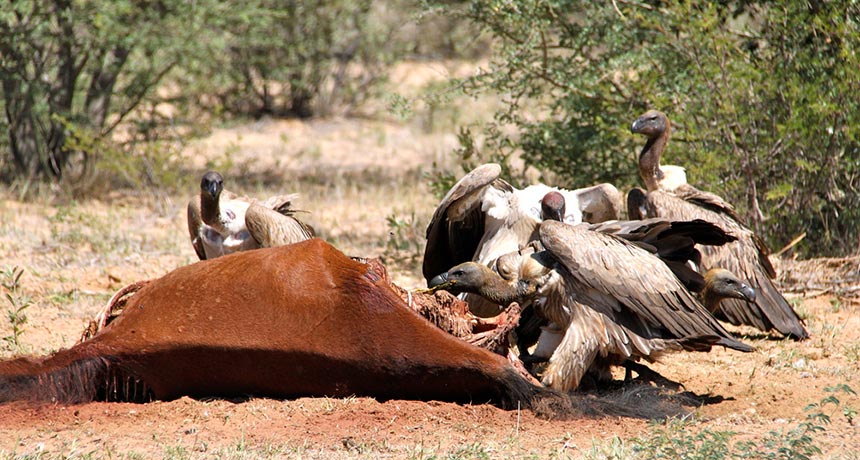Vultures are vulnerable to extinction

Vultures are the birds everyone loves to hate. Even though you have nothing to fear from them — unless you’re dead — vultures’ steady diet of carrion will gross most people out. That diet may also be responsible for the birds’ quick and steep declines around the globe, a new study shows.
It’s not the dead bodies that are killing vultures, though. It’s the poisons with which humans have laced those meals, both intentionally and inadvertently, Evan Buechley and Çağan Şekercioğlu of the University of Utah in Salt Lake City conclude in the June Biological Conservation.
The team went searching for an explanation to something Şekercioğlu had reported in 2004 and is still true today — that vultures are the most threatened group of birds. Of the 22 species of vultures, nine are now critically endangered, three are endangered and four are near threatened, according to the International Union for Conservation of Nature, which tallies endangered species.
Buechley and Şekercioğlu were looking for an explanation of why these scavenging species (called “obligate scavengers” because they depend almost entirely on carrion for survival) are doing so poorly but “facultative scavengers” — birds such as storks, gulls and crows that can also eat things other than carrion and trash — tend to be doing well and even increasing in numbers in many cases. The researchers collected ecological information and population trend data on the 22 species of vultures and other avian scavengers and then tried to figure out what made the vultures so vulnerable.
Some aspects of biology do contribute to the vulture declines, the team found. These are large animals that live long and don’t produce a lot of offspring. That means that populations can take a long time to recover from bird deaths. But the ultimate cause of those deaths is what is disturbing — dietary toxins, which are the primary cause of declines in 14 of the 16 threatened and near-threatened vulture species, the team found.
Those toxins come in various forms. In India and Southeast Asia, it’s the cattle drug diclofenac, which causes kidney failure in any vulture unlucky enough to come across a cow that didn’t survive its medical treatment. Diclofenac is a problem for vultures in Africa, too, (and now Spain), but there the birds have also fallen victim to the poisons used to kill hyenas, jackals and lions in response to dead livestock. Wildlife poachers have also deliberately poisoned their prey in an effort to get rid of the circling vultures that can alert authorities to their crime. (Buechley and Şekercioğlu discovered a 2007 incident in Namibia in which a poisoned elephant carcass killed as many as 600 birds.) And in Europe and the Americas, carcasses laced with rodenticides, insecticides and lead from ammunition are also killing vulture species.
Without vultures, some of these ecosystems are already having problems. Other scavenging species aren’t quite able to fit into the vulture niche. They can’t eat as much and they don’t have stomachs equipped to kill deadly microbes, like vultures do. That means anything that does eat carrion could potentially spread disease. Populations of scavenging pests, like rats and feral dogs, have already skyrocketed in some places as these animals feast on what vultures would have once dealt with. Perhaps not surprisingly, that has led to problems, such as an increase in dog bites in India that has resulted in thousands of human deaths from rabies.
Much of the vulture declines could be easily solved by banning the chemicals that kill them, the researchers note. Because while vultures may be more inherently vulnerable to extinction than other bird species, due to their biology, their importance to the global ecosystem — and our own health — makes them too valuable to let slip away.